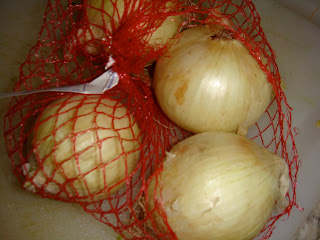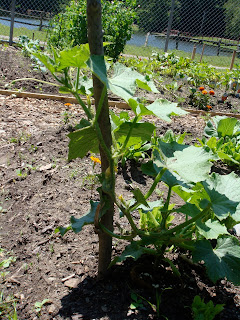Last week I decided to pickle two of the large cucumbers, that I picked from the garden. I looked online for a recipe and thought that this would be an easy task!

Grocery Shopping: The recipe recommended making the pickle juice with a pre-packaged mix that contained all of the seasoning. Unfortunately, the A & P grocery store, does not carry this. In fact, when I asked a stock boy for directions to the pickle mix, he laughed and said he had never seen that before. So I had to make my own pickle juice from scratch with the ingredients I could find at the grocery store. As I picked up each ingredient and looked at the jars of pickles, I realized that it may be less costly and more time efficient to just buy the jar of kosher dill pickles. But, I was excited and determined to persevere through my experiment!
Ingredients for pickles!
Pickle Juice Recipe: Unfortunately, I had to modify the original recipe slightly, what I changed I have put in italics next to the original ingredient:
1/3 cup sugar or splenda
1/3 cup kosher salt
1/2 cup packed fresh dill
2 white onions peeled & chopped finely (I substituted 5 teaspoons of onion powder)
3 cloves garlic, peeled & thinly sliced or 3 level teaspoons prepared (minced) garlic (I used minced garlic)
1 tsp mustard or celery seed
To this mixture I added 2 cups of clear vinegar
I heated this mixture to a slight boil, while I cut the pickles into long spears.
The dry ingredients, sans vinegar
The cucumber spears
As I occasionally stirred the mixture, I was curious about how it was going to turn out. I decided to lean my head towards the mixture and get a slight whiff of it. Big mistake! I had boiling vinegar and garlic and onion waft up my nose, and it stung! So a word of caution to everyone who is as curious as me, do not smell the pickle juice!
boiling pickle juice
Where it all goes wrong: The recipe I had found called for you to pour the pickle juice into glass jars containing the pickle spears. This was supposed to fill up to within 1/4 inch of the top. Unfortunately, as soon as I poured this boiling water into the jar I heard a crack! My great-grandmothers mason jar had cracked along the bottom, and pickle juice was seeping out on top of the counter!
Cracked jar

I scrambled to save what juice I could. I put the cracked glass jar back into the pot so that all the juice could be collected, and I scrubbed the counter trying to get the biting small to not stick. Unfortunately, when I tried to pour the salvaged pickle juice into a new glass jar, it only filled half of the cucumbers. I tried to imagine what a half-pickled cucumber spear would look like, and hated the thought.
Instead, I took out the cucumber spears, chopped them in half and put them back in the jar. Though the pickle juice didn't fill the container fully, at least it covered the cucumbers. I then screwed on the lid placed it in the fridge, and hoped for the experiment was a success.
Then I waited: For one full week I waited to taste my first pickle.
Moment of Truth: Last night I was finally able to taste my pickles and . . . they didn't taste bad! In fact, they tasted pretty good! The pickles taste like dill pickles, but they also have a slightly tangy sweet taste. I can't quite place it, but I am sure that to get a genuine dill pickle taste I would just have to make sure I used real white onions next time.
So this experiment was happily a success. And I look forward to trying it again!






























 Sweet Basil
Sweet Basil

















